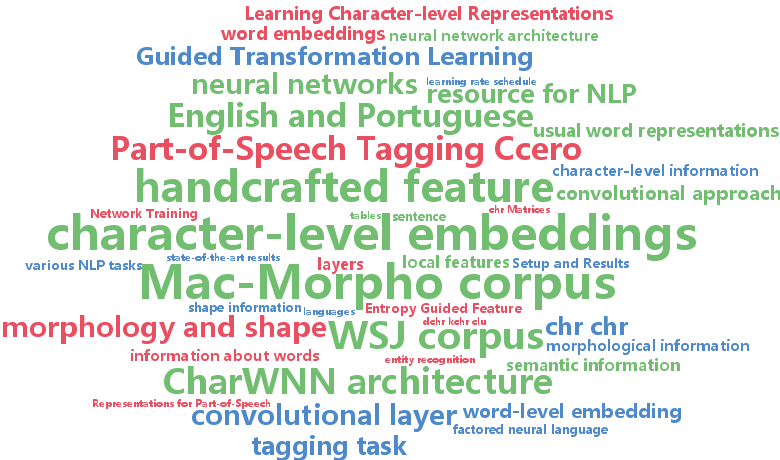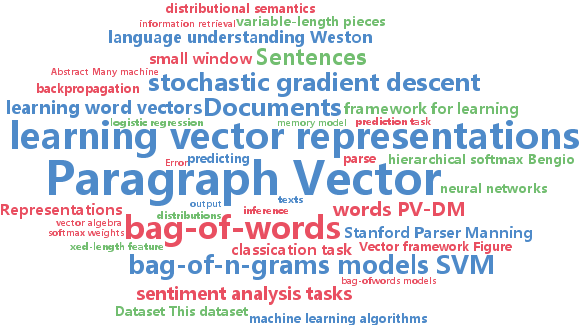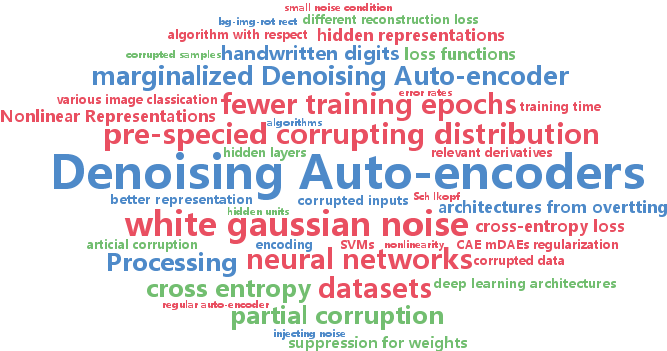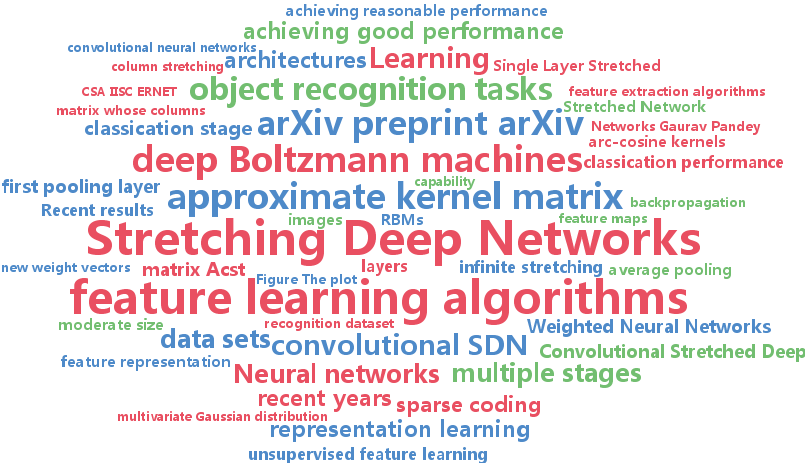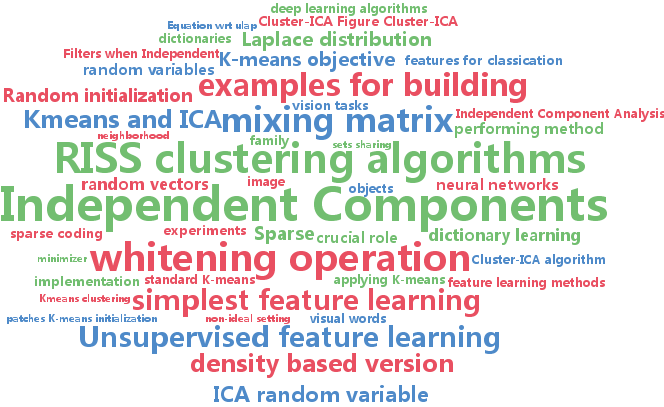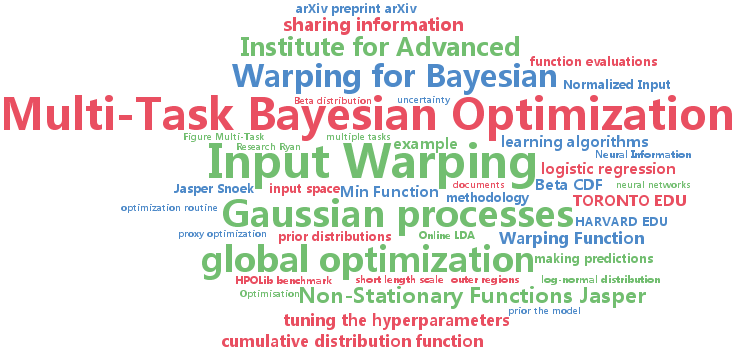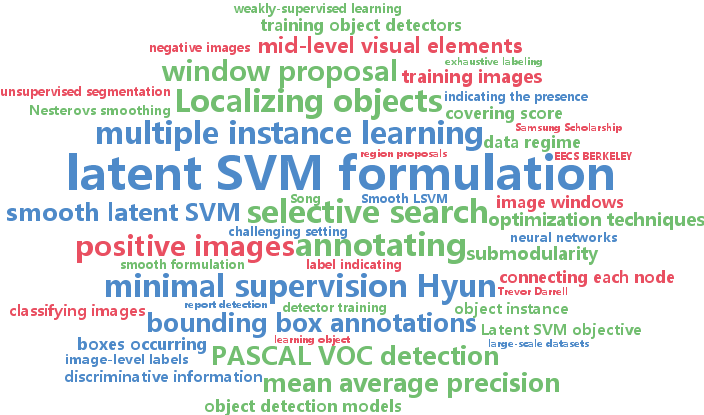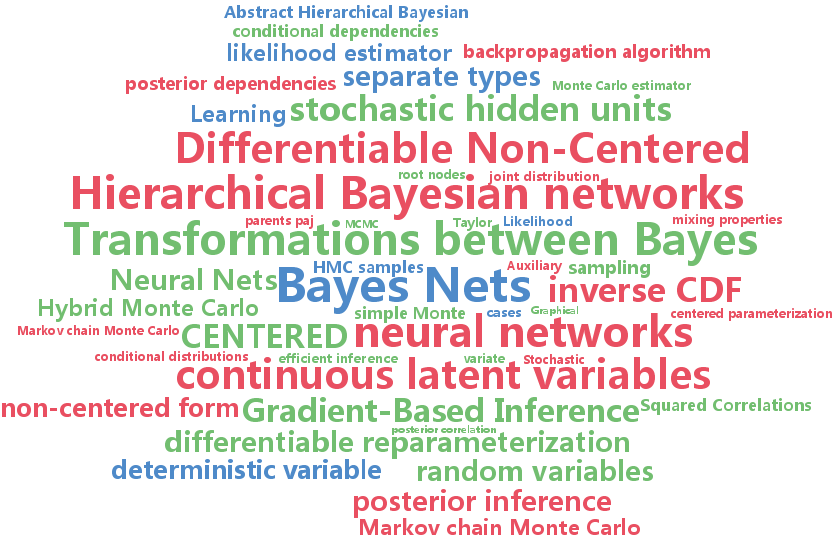neural networks
-
Cicero Dos Santos and Bianca Zadrozny
Learning Character-level Representations for Part-of-Speech Tagging (pdf)
Distributed word representations have recently been proven to be an invaluable resource for NLP. These representations are normally learned using neural networks and capture syntactic and semantic information about words. Information about word morphology and shape is normally ignored when learning word representations. However, for tasks like part-of-speech tagging, intra-word information is extremely useful, specially when dealing with morphologically rich languages. In this paper, we propose a deep neural network that learns character-level representation of words and associate them with usual word representations to perform POS tagging. Using the proposed approach, while avoiding the use of any handcrafted feature, we produce state-of-the-art POS taggers for two languages: English, with 97.32% accuracy on the Penn Treebank WSJ corpus; and Portuguese, with 97.47% accuracy on the Mac-Morpho corpus, where the latter represents an error reduction of 12.2% on the best previous known result.
-
Jan Botha and Phil Blunsom
Compositional Morphology for Word Representations and Language Modelling (pdf)
This paper presents a scalable method for integrating compositional morphological representations into a vector-based probabilistic language model. Our approach is evaluated in the context of log-bilinear language models, rendered suitably efficient for implementation inside a machine translation decoder by factoring the vocabulary. We perform both intrinsic and extrinsic evaluations, presenting results on a range of languages which demonstrate that our model learns morphological representations that both perform well on word similarity tasks and lead to substantial reductions in perplexity. When used for translation into morphologically rich languages with large vocabularies, our models obtain improvements of up to 1.2 BLEU points relative to a baseline system using back-off n-gram models.
-
Jian Zhou and Olga Troyanskaya
Deep Supervised and Convolutional Generative Stochastic Network for Protein Secondary Structure Prediction (pdf)
Predicting protein secondary structure is a fundamental problem in protein structure prediction. Here we present a new supervised generative stochastic network (GSN) based method to predict local secondary structure with deep hierarchical representations. GSN is a recently proposed deep learning technique (Bengio&Thibodeau-Laufer, 2013) to globally train deep generative model. We present the supervised extension of GSN, which learns a Markov chain to sample from a conditional distribution, and applied it to protein structure prediction. To scale the model to full-sized, high-dimensional data, like protein sequences with hundreds of amino-acids, we introduce a convolutional architecture, which allows efficient learning across multiple layers of hierarchical representations. Our architecture uniquely focuses on predicting structured low-level labels informed with both low and high-level representations learned by the model. In our application this corresponds to labeling the secondary structure state of each amino-acid residue. We trained and tested the model on separate sets of non-homologous proteins sharing less than 30% sequence identity. Our model achieves 66.4% Q8 accuracy on the CB513 dataset, better than the previously reported best performance 64.9% (Wang et al., 2011) for this challenging secondary structure prediction problem.
-
Quoc Le and Tomas Mikolov
Distributed Representations of Sentences and Documents (pdf)
Many machine learning algorithms require the input to be represented as a fixed length feature vector. When it comes to texts, one of the most common representations is bag-of-words. Despite their popularity, bag-of-words models have two major weaknesses: they lose the ordering of the words and they also ignore semantics of the words. For example, "powerful," "strong" and "Paris" are equally distant. In this paper, we propose an unsupervised algorithm that learns vector representations of sentences and text documents. This algorithm represents each document by a dense vector which is trained to predict words in the document. Its construction gives our algorithm the potential to overcome the weaknesses of bag-of-words models. Empirical results show that our technique outperforms bag-of-words models as well as other techniques for text representations. Finally, we achieve new state-of-the-art results on several text classification and sentiment analysis tasks.
-
Minmin Chen and Kilian Weinberger and Fei Sha and Yoshua Bengio
Marginalized Denoising Auto-encoders for Nonlinear Representations (pdf)
Denoising auto-encoders (DAEs) have been successfully used to learn new representations for a wide range of machine learning tasks. During training, DAEs make many passes over the training dataset and reconstruct it from partial corruption generated from a pre-specified corrupting distribution. This process learns robust representation, though at the expense of requiring many training epochs, in which the data is explicitly corrupted. In this paper we present the marginalized Denoising Auto-encoder (mDAE), which (approximately) marginalizes out the corruption during training. Effectively, the mDAE takes into account infinitely many corrupted copies of the training data in every epoch, and therefore is able to match or outperform the DAE with much fewer training epochs. We analyze our proposed algorithm and show that it can be understood as a classic auto-encoder with a special form of regularization. In empirical evaluations we show that it attains 1-2 order-of-magnitude speedup in training time over other competing approaches.
-
Gaurav Pandey and Ambedkar Dukkipati
Learning by Stretching Deep Networks (pdf)
In recent years, deep architectures have gained a lot of prominence for learning complex AI tasks because of their capability to incorporate complex variations in data within the model. However, these models often need to be trained for a long time in order to obtain good results. In this paper, we propose a technique, called `stretching', that allows the same models to perform considerably better with very little training. We show that learning can be done tractably, even when the weight matrix is stretched to infinity, for some specific models. We also study tractable algorithms for implementing stretching in deep convolutional architectures in an iterative manner and derive bounds for its convergence. Our experimental results suggest that the proposed stretched deep convolutional networks are capable of achieving good performance for many object recognition tasks. More importantly, for a fixed network architecture, one can achieve much better accuracy using stretching rather than learning the weights using backpropagation.
-
Ke Sun and Stéphane Marchand-Maillet
An Information Geometry of Statistical Manifold Learning (pdf)
Manifold learning seeks low-dimensional representations of high-dimensional data. The main tactics have been exploring the geometry in an input data space and an output embedding space. We develop a manifold learning theory in a hypothesis space consisting of models. A model means a specific instance of a collection of points, e.g., the input data collectively or the output embedding collectively. The semi-Riemannian metric of this hypothesis space is uniquely derived in closed form based on the information geometry of probability distributions. There, manifold learning is interpreted as a trajectory of intermediate models. The volume of a continuous region reveals an amount of information. It can be measured to define model complexity and embedding quality. This provides deep unified perspectives of manifold learning theory.
-
Yoshua Bengio and Eric Laufer and Guillaume Alain and Jason Yosinski
Deep Generative Stochastic Networks Trainable by Backprop (pdf)
We introduce a novel training principle for probabilistic models that is an alternative to maximum likelihood. The proposed Generative Stochastic Networks (GSN) framework is based on learning the transition operator of a Markov chain whose stationary distribution estimates the data distribution. Because the transition distribution is a conditional distribution generally involving a small move, it has fewer dominant modes, being unimodal in the limit of small moves. Thus, it is easier to learn, more like learning to perform supervised function approximation, with gradients that can be obtained by backprop. The theorems provided here generalize recent work on the probabilistic interpretation of denoising autoencoders and provide an interesting justification for dependency networks and generalized pseudolikelihood (along with defining an appropriate joint distribution and sampling mechanism, even when the conditionals are not consistent). GSNs can be used with missing inputs and can be used to sample subsets of variables given the rest. Successful experiments are conducted, validating these theoretical results, on two image datasets and with a particular architecture that mimics the Deep Boltzmann Machine Gibbs sampler but allows training to proceed with backprop, without the need for layerwise pretraining.
-
Alon Vinnikov and Shai Shalev-Shwartz
K-means recovers ICA filters when independent components are sparse (pdf)
Unsupervised feature learning is the task of using unlabeled examples for building a representation of objects as vectors. This task has been extensively studied in recent years, mainly in the context of unsupervised pre-training of neural networks. Recently, (Coates et al., 2011) conducted extensive experiments, comparing the accuracy of a linear classifier that has been trained using features learnt by several unsupervised feature learning methods. Surprisingly, the best performing method was the simplest feature learning approach that was based on applying the K-means clustering algorithm after a whitening of the data. The goal of this work is to shed light on the success of K-means with whitening for the task of unsupervised feature learning. Our main result is a close connection between K-means and ICA (Independent Component Analysis). Specifically, we show that K-means and similar clustering algorithms can be used to recover the ICA mixing matrix or its inverse, the ICA filters. It is well known that the independent components found by ICA form useful features for classification (Le et al., 2012; 2011; 2010), hence the connection between K-mean and ICA explains the empirical success of K-means as a feature learner. Moreover, our analysis underscores the significance of the whitening operation, as was also observed in the experiments reported in (Coates et al., 2011). Finally, our analysis leads to a better initialization of K-means for the task of feature learning.
-
Jasper Snoek and Kevin Swersky and Rich Zemel and Ryan Adams
Input Warping for Bayesian Optimization of Non-Stationary Functions (pdf)
Bayesian optimization has proven to be a highly effective methodology for the global optimization of unknown, expensive and multimodal functions. The ability to accurately model distributions over functions is critical to the effectiveness of Bayesian optimization. Although Gaussian processes provide a flexible prior over functions, there are various classes of functions that remain difficult to model. One of the most frequently occurring of these is the class of non-stationary functions. The optimization of the hyperparameters of machine learning algorithms is a problem domain in which parameters are often manually transformed a priori, for example by optimizing in "log-space", to mitigate the effects of spatially-varying length scale. We develop a methodology for automatically learning a wide family of bijective transformations or warpings of the input space using the Beta cumulative distribution function. We further extend the warping framework to multi-task Bayesian optimization so that multiple tasks can be warped into a jointly stationary space. On a set of challenging benchmark optimization tasks, we observe that the inclusion of warping greatly improves on the state-of-the-art, producing better results faster and more reliably.
-
Hyun Oh Song and Ross Girshick and Stefanie Jegelka and Julien Mairal and Zaid Harchaoui and Trevor Darrell
On learning to localize objects with minimal supervision (pdf)
Learning to localize objects with minimal supervision is an important problem in computer vision, since large fully annotated datasets are extremely costly to obtain. In this paper, we propose a new method that achieves this goal with only image-level labels of whether the objects are present or not. Our approach combines a discriminative submodular cover problem for automatically discovering a set of positive object windows with a smoothed latent SVM formulation. The latter allows us to leverage efficient quasi-Newton optimization techniques. Our experiments demonstrate that the proposed approach provides a 50% relative improvement in mean average precision over the current state-of-the-art on PASCAL VOC 2007 detection.
-
Diederik Kingma and Max Welling
Efficient Gradient-Based Inference through Transformations between Bayes Nets and Neural Nets (pdf)
Hierarchical Bayesian networks and neural networks with stochastic hidden units are commonly perceived as two separate types of models. We show that either of these types of models can often be transformed into an instance of the other, by switching between centered and differentiable non-centered parameterizations of the latent variables. The choice of parameterization greatly influences the efficiency of gradient-based posterior inference; we show that they are often complementary to eachother, we clarify when each parameterization is preferred and show how inference can be made robust. In the non-centered form, a simple Monte Carlo estimator of the marginal likelihood can be used for learning the parameters. Theoretical results are supported by experiments.
